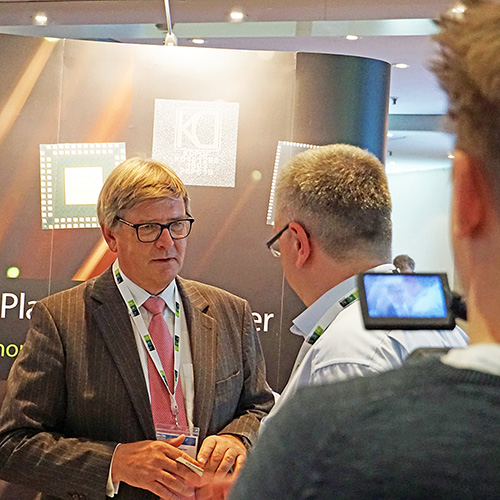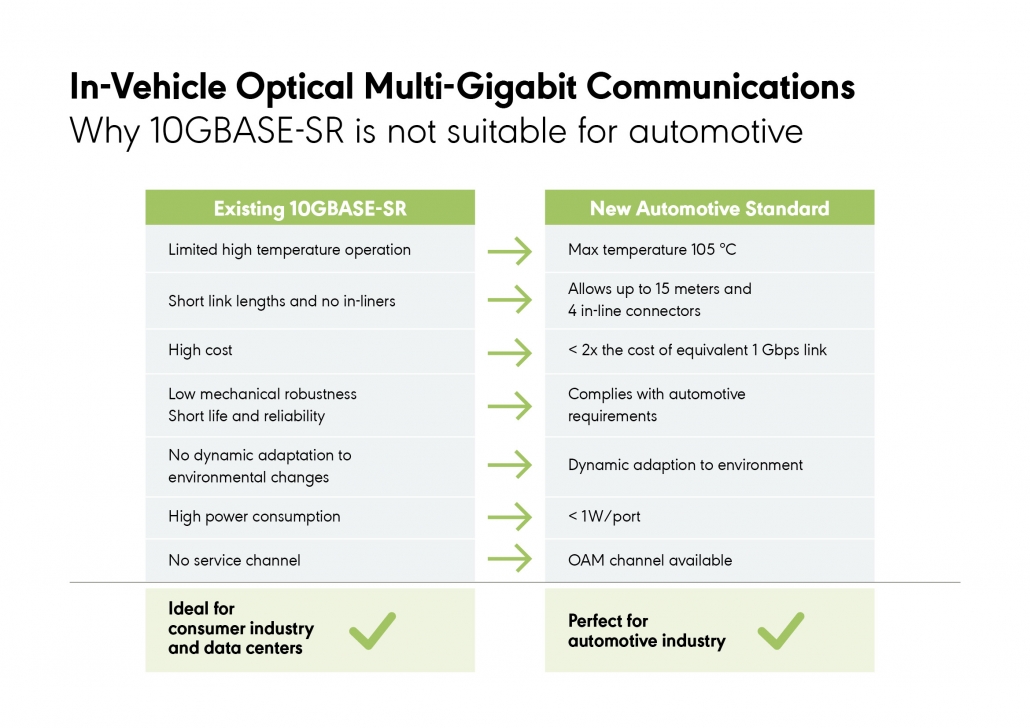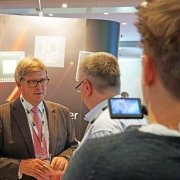César Esteban, Application and Support Manager of KDPOF, is demonstrating a Proof-of-Concept of an automotive optical surround view system: the four cameras on top of a demo car are transmitting video data at 100 Megabits per second to their corresponding media converters. The media converters are converting from copper to optical: one, two, three, and four, one for each camera. The blinking green LED on the media converter indicates that the data traffic is running through. The orange LED shows that the optical link is at 100 Mbps. The traffic is sent to this optical GEPOF (Gigabit Ethernet Plastic Optical Fiber) switch, which has five ports. The four left ports are in orange because these are from the cameras with 100 Mbps each. The green LED on the right is the GEPOF link with 1 Gigabit per second. It is linked to this fifth media converter that is aggregating the traffic of the four cameras. The four video sequences are transmitted to a PC, which functions as display unit. The four streams are displayed simultaneously. The hosted hub consists of the GEPOF switch and five media converters.
Currently, the automotive industry is seeking technologies to enable 10 Gbps communications. This derives from the growing need of data interchange between sensors and electronic control units in the car. Infotainment, ADAS and growing levels of autonomy are the key trends that explain the exponential growth of data rates: 100 Mbps to 1 Gbps and to 10 Gbps. Some OEMs are even talking about 25 and 50 Gbps for the upcoming years.
Why 10GBASE-SR is not suitable for automotive
Ideally, an existing standard would work for automotive applications. 10GBASE-SR is the current standard by IEEE to establish a communications channel in optical fiber at 10 Gbps. It was originally created to meet the demands of data centers where temperature, operating life, price, reliability and mechanical robustness are very controlled and modest. Unfortunately, it does not meet the stringent automotive requirements. When automotive requirements are applied, the link budget offered by 10GBASE-SR is too low to be acceptable. Several suppliers of fiber optics components propose OEMs solutions like sleeves and ferrules, which are working concerning performance. But, what is the cost, what is the yield?
New Automotive Standard Mandatory
Due to all these reasons, and with, power consumption and especially cost being key in automotive applications, only a new communications scheme is able to provide larger margins and to adapt itself automatically to varying environmental conditions and manufacturing process variations. Moreover, the new standard should be a scalable technology in order to enable even higher data rates such as 25, 50, and 100 Gbps in the future. By combining optimization in all areas of the new standard, the right balance in complexity and cost among all parts (CMOS IC, VCSEL, PD, ferrules, sleeves, cable, in-line connection technology, optics, and lenses, etc.) can be achieved in order to deliver the lowest cost, most reliable, and highly scalable solution to the automotive market.
A team of individuals affiliated with more than 15 key carmakers, such as PSA, Toyota, and Volvo, Tier1s, and components suppliers, including KDPOF, is leading a Call for Interest (CFI). The team is specifying the needs and technologies to support the new standard for 10 Gbps in automotive that will complement the existing 10GBASE-SR. The working group is expected to kick off in the summer of 2019, with the first prototypes to be projected by the end of 2021. The objective of the CFI is to get approval by the IEEE to start the standardization of an IEEE 802.3 Automotive Optical Multi-Gigabit Standard. We warmly welcome you to join the CFI initiative!

KDPOF will partner with ZLGMCU, a leading microcontroller and embedded solutions provider in China, through a value-added technology and distribution agreement. The Chinese partner will provide market access in the Greater China region to KDPOF. This strategic agreement will open the huge electrified powertrain market in Greater China to the optical communications technology. Chinese OEMs and Tier1s are in need of a technology that is able to withstand the electrical noise generated in the electrical converters and motors.

In order to improve our services and provide a short line of communication in Central Europe, Jürgen Schachtschneider and Markus Dittmann have recently joined the KDPOF team. Jürgen Schachtschneider focusses on Automotive Business Development for Central Europe and Greater China. He is an expert in the automotive electronics industry who has held positions as Vice President of NXP and Nexperia.
Markus Dittmann supports KDPOF as Fiber Optics Connectivity R&D engineer. He has previously been R&D Product Development Engineer/Project Coordinator with TE Connectivity and Harman/Becker. As a technical project manager, he is responsible for effective cooperation with suppliers and partners in development projects in which connection solutions play an important role in the overall system. In addition to his responsibility for development activities with manufacturers of optical connectors for automotive Ethernet cable sets, Markus Dittmann is also involved in management, design, production testing and standardization activities.








